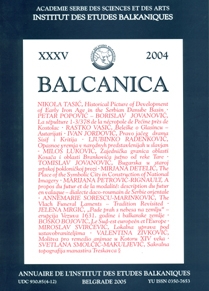Istorijska slika razvoja ranog gvozdenog doba u srpskom Podunavlju
Historical Picture of Development of Early Iron Age in the Serbian Danube Basin
Author(s): Nikola TasićSubject(s): Archaeology
Published by: Balkanološki institut - Srpska akademija nauka i umetnosti
Keywords: early iron age; Serbian Danube basin; culture;
Summary/Abstract: The paper o.ers a historical survey of the development of Early Iron Age cultures in Danubian Serbia, its characteristics, relations with contemporary cultures of the Pannonian Plain, the Balkans, Carpathian Romania (Transylvania) and the Romanian Banat. It describes the genesis of individual cultures, their styles, typological features and interrelationships. Danubian Serbia is seen as a contact zone re.ecting in.uences of the Central European Urnenfelder culture on the one hand, and those of the Gornea-Kalakača and the Bosut-Basarabi complex on the other. The latter’s penetration into the central Balkans south of the Sava and Danube rivers has been registered in the Morava valley, eastern Serbia, north-western Bulgaria and as far south as northern Macedonia. The terminal Early Iron Age is marked by the occurrence of Scythian .nds in the southern Banat, Bačka or around the con.uence of the Sava and the Danube (e.g. Ritopek), and by representative .nds of the Srem group in Srem and around the con.uence of the Tisa and Danube rivers. The powerful penetration of Celtic tribes from Central Europe into the southern Pannonian Plain marked the end of the Early Iron Age.
Journal: BALCANICA
- Issue Year: 2004
- Issue No: 35
- Page Range: 5-23
- Page Count: 16
- Language: English

